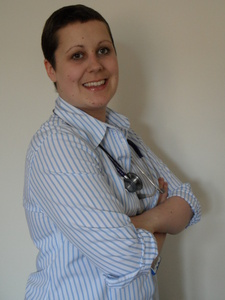Kate Miriam Granger MBE FRCP (31 October 1981 – 23 July 2016) who was an English geriatrician and campaigner for better patient care. In 2011, she was diagnosed with desmoplastic small-round-cell tumor (DSRCT), a type of sarcoma, and subsequently started the “#hellomynameis” campaign. While encouraging healthcare staff to introduce themselves to patients. http://www.sarcomahelp.org/stories/dsrct-kate.html
Granger first became ill when on holiday in California in July 2011 with her husband Chris Pointon. She was treated in the Emergency Room in Santa Cruz when her kidneys failed. She returned to Leeds and was given further tests. When told the diagnosis, she knew that DSRCT that had metastasized had “an utterly dismal prognosis”. She was treated with P6 protocol chemotherapy and endured painful treatments which she described in detail in her blog “The Other Side and the Bright Side”.
She described how the news that her condition was incurable was broken to her:
If you can put yourself in my position – I’m 29 years old, I know I’ve got cancer, I think it’s confined to my abdomen so I’m expecting to have an operation, maybe some chemotherapy and possibly a cure. I’m in a side room. I can hear everything that’s going on outside. I’m in pain and alone. A junior doctor comes to see me to talk to me about the results of the MRI scan I’d had earlier in the week. I’d never met this doctor before.
He came into my room, he sat down in the chair next to me and looked away from me. Without any warning or asking if I wanted anyone with me he just said, “Your cancer has spread”. He then could not leave the room quick enough and I was left in deep psychological distress. I never saw him again. I am a little bit psychologically scarred by that experience.
After her diagnosis, Granger continued her medical training and qualified as a consultant geriatrician. During the latter stages of her illness, she was treated at St Gemma’s Hospice, Leeds. Kate passed away peacefully surrounded by loved ones on Saturday 23rd July 2016 aged 34.
 What is it like to live with a terminal illness?
What is it like to live with a terminal illness?
Kate Granger’s story:
Kate Granger, who was told her cancer was incurable, describes her battle to maintain a normal life. The median length of life from diagnosis to death for those patients with desmoplastic small-round-cell tumor is reported in medical literature as 14 months.
That technically means my time should be up in October, but I’m doing well and will in all probability survive longer than this. Living with death hanging over me and everything I do while still smiling and staying positive is incredibly difficult. I feel like I’m constantly struggling to push it to the back of my mind but never quite succeeding. In fact, the sad thing is I can’t remember what it was like not to have a terminal cancer diagnosis.
There are constant reminders, which mean that even if I could forget what is happening to me, I would never be allowed to: the regular visits for follow-up appointments at the hospital; the daily battle to swallow the 12 pills I have to take to keep my symptoms under control; the frequent “How are you?” questions that always have a deeper meaning than just a simple enquiry about my welfare.
I was always very clear that once I discontinued my palliative chemotherapy in January I wanted to return some normality to my life, for however long that may be. A huge part of this was going back to work. Many people thought I was crazy to contemplate returning to a stressful job as an elderly medicine registrar at a busy district general hospital, but I was determined. And I was completely right to return.
Working has given me a focus again, and I think I still have a great deal to give – probably more than before my own illness. I struggle with fatigue, but this is something I am determined is not going to beat me, so I work 3 full days a week and put everything into my job that I used to. I would hate to be thought of at work as the poor young dying doctor, preferring to retain my pre-cancer personality – the competent, hardworking registrar who gets stuff sorted and cares about her patients.
My “maintaining normality for as long as possible” mantra also extends to my home life. I still do the housework and the cooking. I sit and watch the soaps in the evening. I enjoy regular Sunday lunches with my family. I swim up to 50 lengths at my local pool.
The routine of life goes on and is vital in keeping both myself and my husband on an even keel, although life is also now sprinkled with wonderful, invigorating experiences. After five grueling rounds of chemotherapy following her diagnosis. . . with a rare and aggressive form of sarcoma in July 2011, Kate decided to stop receiving treatment and concentrate on enjoying a good quality of life.
Kate wrote a ‘Bucket List’ when she discovered she was terminally ill. This has included renewing her wedding vows, afternoon tea at the Savoy, dinner at Claridges, a flight in a glider, a visit to the zoo, a spa day with the girls and trips to Paris, Edinburgh and the East Coast. Kate’s list continues to grow. bucketlist.org/list/kategranger
One coping strategy I have is to live my life on a two-month window. I find it very hard to think any further ahead than this, although sometimes I am forced to. For example, my brother and his wife are expecting their first child in January. Meeting the newest member of our family is a long-term goal that I would dearly love to achieve. Likewise, two of my best friends have just got engaged and are planning summer weddings. I would love to be able to perform bridesmaid and cake-baking duties, but there is a strong possibility I will no longer be here by then.
If you want to read more about Kate’s story, her books The Other Side and The Bright Side can be ordered from her website. All proceeds from sales of the books are being donated to the Yorkshire Cancer Centre. https://www.telegraph.co.uk/women/life/dr-kate-granger-i-blogged-about-my-death—but-then-i-didnt-die/



